Directed Energy Weapons Market Size
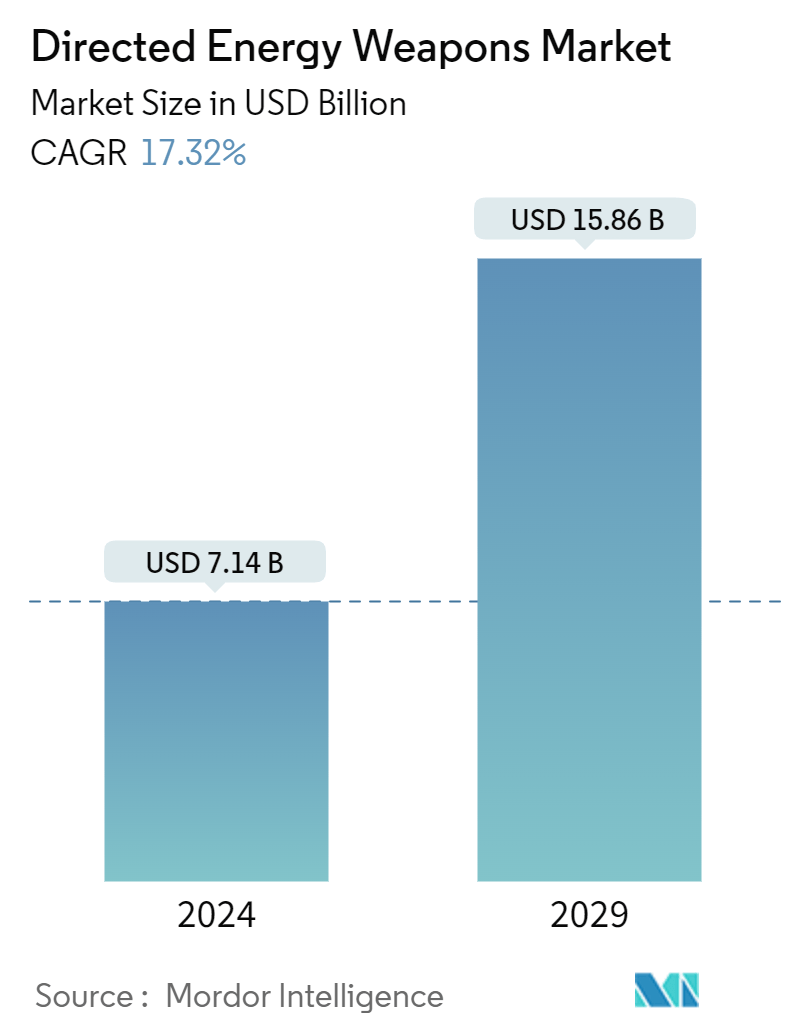
| Study Period | 2019 - 2029 |
| Market Size (2024) | USD 7.14 Billion |
| Market Size (2029) | USD 15.86 Billion |
| CAGR (2024 - 2029) | 17.32 % |
| Fastest Growing Market | North America |
| Largest Market | North America |
Major Players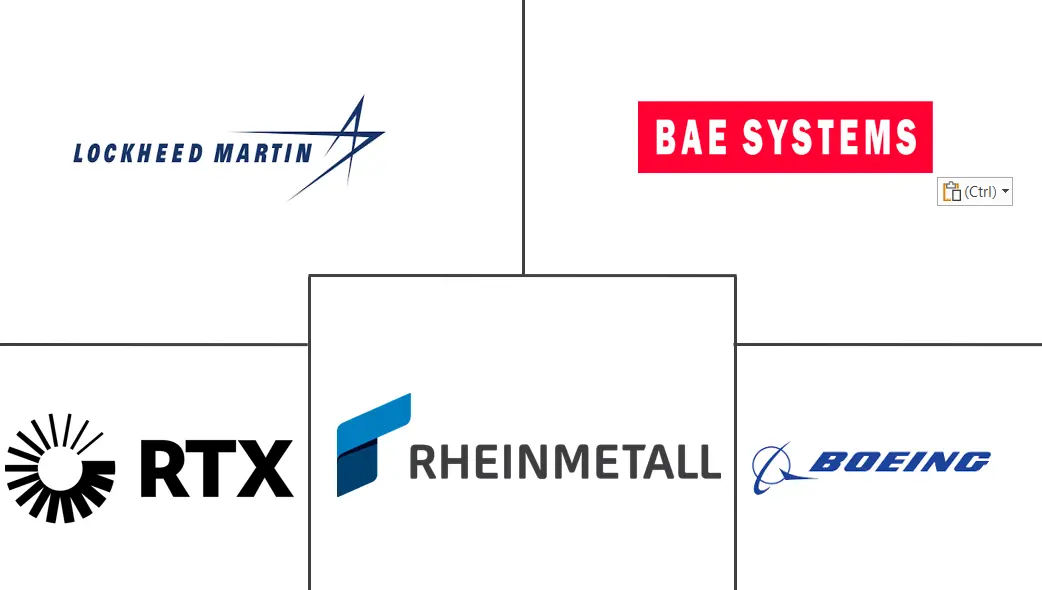
*Disclaimer: Major Players sorted in no particular order |
Directed Energy Weapons Market Analysis
The Directed Energy Weapons Market size is estimated at USD 7.14 billion in 2024, and is expected to reach USD 15.86 billion by 2029, growing at a CAGR of 17.32% during the forecast period (2024-2029).
The rapid increase in the military expenditures of developed and emerging countries due to increasing geopolitical tensions is accelerating the procurement of new air, land, and sea platforms. The armed forces are investing in the integration of advanced weapon systems, such as directed energy weapons and onboard vehicles, driving the growth of the market. The increasing threat of rockets, missiles, crewless air vehicles, etc., accelerates the development and deployment of directed energy weapons.
Currently, most countries are working on integrating counter-UAV laser systems into their armed forces, which can later be scaled into complete air defense systems. Directed energy weapons offer a more cost-effective, high-speed, highly accurate method to counter aerial threats than a highly expensive missile to destroy moderate-level threats, like small drones. Such factors are driving the growth of the market.
High development and operational costs are significant barriers to widespread adoption. Technical hurdles, including power supply stability, beam accuracy, and atmospheric interference, further complicate matters. Regulatory hurdles, the necessity for extensive testing, and ethical concerns about potential misuse also slow down DEW deployment. Market players must navigate these challenges while ensuring compliance with international treaties and laws.
Advanced energy storage and power management technologies are pivotal for enhancing DEW effectiveness and portability. Strategic partnerships among defense contractors, technology firms, and government bodies are instrumental in propelling the market forward. Additionally, integrating DEWs into existing military assets like drones and naval vessels is bolstering market growth.
Directed Energy Weapons Market Trends
The Sea Segment is Projected to Witness the Highest Growth During the Forecast Period
Propelled by robust defense spending and a drive to adopt directed energy weapon (DEW) technology, the sea segment is expected to record the highest CAGR during the forecast period. Governments worldwide, notably the US, are arming their combat ships, from destroyers to frigates, with DEWs to counter a spectrum of threats, be it from ships, UAVs, or missiles. The US Navy, in particular, has been at the forefront, integrating DEWs into its naval arsenal for over half a decade. Highlighting this commitment are flagship programs like the High Energy Laser Counter-ASCM Program (HELCAP), Optical Dazzling Interdictor, Navy (ODIN), Solid-State Laser Technology Maturation (SSL-TM), and the Surface Navy Laser Weapon System (SNLWS), famously known as HELIOS.
In April 2024, the UK Royal Navy announced plans to roll out its DragonFire laser-directed energy weapon (LDEW) systems, with deployment slated to commence in 2027. This accelerated timeline, a significant leap from the previous 2032 projection, could be credited to acquisition reforms spearheaded by the Ministry of Defence (MoD) in the 2024-25 financial year. The development of these LDEW systems is a collaborative effort led by MBDA UK, with key contributions from Leonardo and QinetiQ, facilitated through the MoD’s Defence Science and Technology Laboratory (Dstl).
The escalating challenges of piracy, terrorism, and maritime disputes have underscored the critical need for bolstered naval defenses. Directed Energy Weapons (DEWs) have emerged as a pivotal solution, offering a non-lethal means to neutralize adversary vessels and equipment. As the focus on protecting crucial maritime assets, such as ports and offshore platforms, intensifies, the demand for advanced directed energy technologies continues to surge.
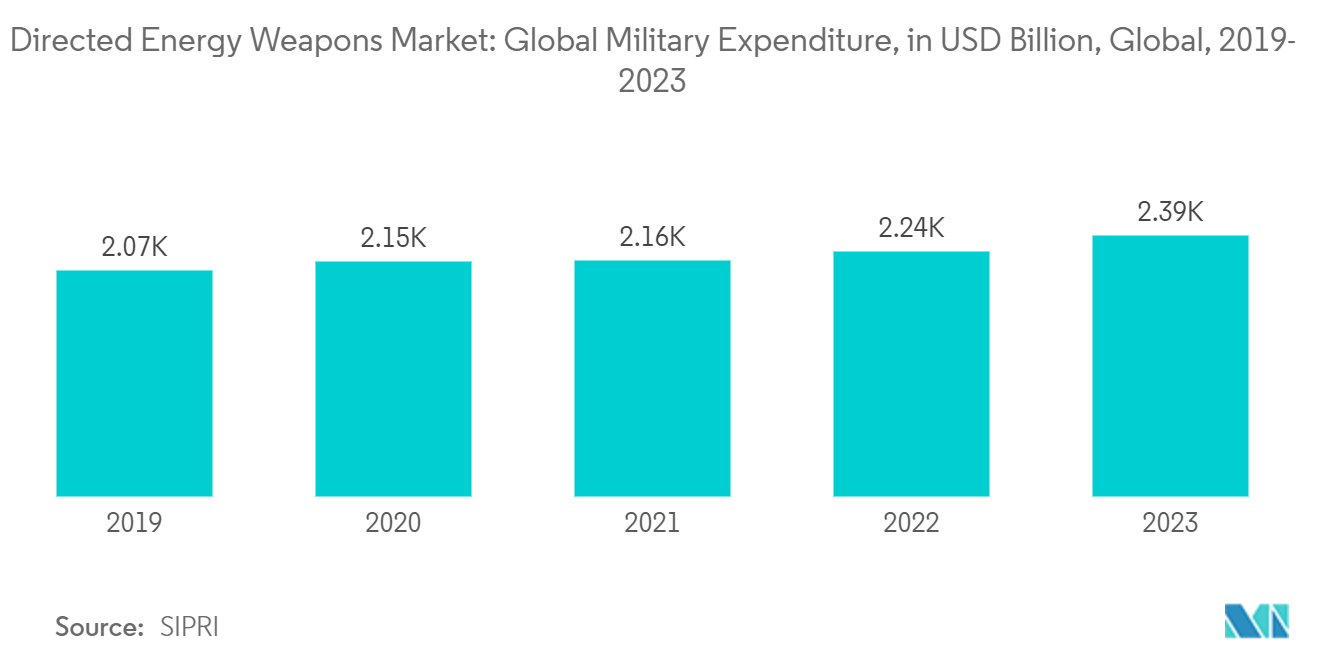
North America is Expected to Dominate Market Share During the Forecast Period
The North American market, spearheaded by substantial investments from the US Department of Defense (DoD), is at the forefront of integrating directed energy weapon technology into its military branches. In recent years, the DoD struck deals with major players such as RTX Corporation, Lockheed Martin Corporation, and Boeing Company, emphasizing advancing and deploying these cutting-edge weapons.
Under the Self-Protect High Energy Laser Demonstrator (SHiELD) Advanced Technology Demonstration Program, the Air Force Research Laboratory is leading the charge in developing laser systems for fighter jets, bolstering their defense against incoming missiles. In a significant move, Lockheed Martin clinched a USD 26.3 million contract from the US Air Force to craft a fiber laser set for testing by 2024.
In December 2023, nLIGHT Inc. secured a USD 34.5 million contract over 18 months to supply a High Energy Laser (HEL) for the US Army’s RCCTO DE M-SHORAD initiative. Acting as a subcontractor to KORD Technologies, nLIGHT was tasked with creating a 50 kW-class laser system for seamless integration onto Stryker combat vehicles. This HEL system is designed to bolster air and missile defense, targeting a range of threats from crewless aircraft systems to rockets, artillery, and aircraft. Notably, directed energy laser weapons offer a cost-effective alternative, boasting a larger operational capacity and a reduced footprint compared to traditional kinetic weapons.
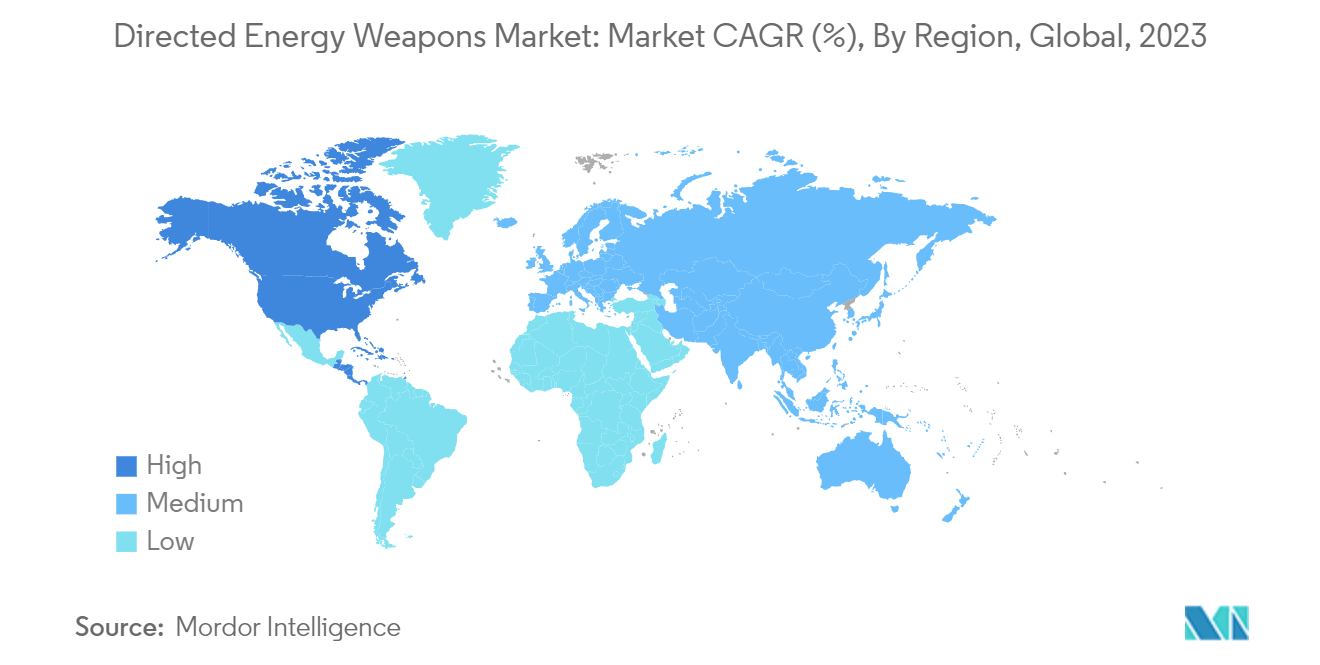
Directed Energy Weapons Industry Overview
The directed energy weapons market is semi-consolidated, with key players including Lockheed Martin Corporation, BAE Systems PLC, Rheinmetall AG, The Boeing Company, and RTX Corporation leading the way. Beyond these direct DEW manufacturers, significant contributions come from players like L3Harris Technologies Inc., QinetiQ Group, and Honeywell International Inc., who specialize in supplying components to the DEW ecosystem.
The trend of defense manufacturers, platform developers, and tech firms increasingly collaborating to advance DEW systems, particularly for ground and naval applications, is noteworthy. For example, SIGN4L, a subsidiary of the UAE's EDGE conglomerate, partnered with MBDA and CILAS (an Ariane Group subsidiary) to explore high-energy laser applications, spanning operational analysis and systems architecture. Highlighting this trend, in September 2023, Raytheon UK, a division of RTX, received its inaugural 15-kilowatt high-energy laser system for testing and integration under the UK Ministry of Defence's Land Demonstrator program. This laser system, tailored to combat aerial threats like unmanned aerial vehicles (UAVs), marked a significant milestone for the UK's defense capabilities.
Directed Energy Weapons Market Leaders
-
Lockheed Martin Corporation
-
The Boeing Company
-
Rheinmetall AG
-
RTX Corporation
-
BAE Systems plc
*Disclaimer: Major Players sorted in no particular order
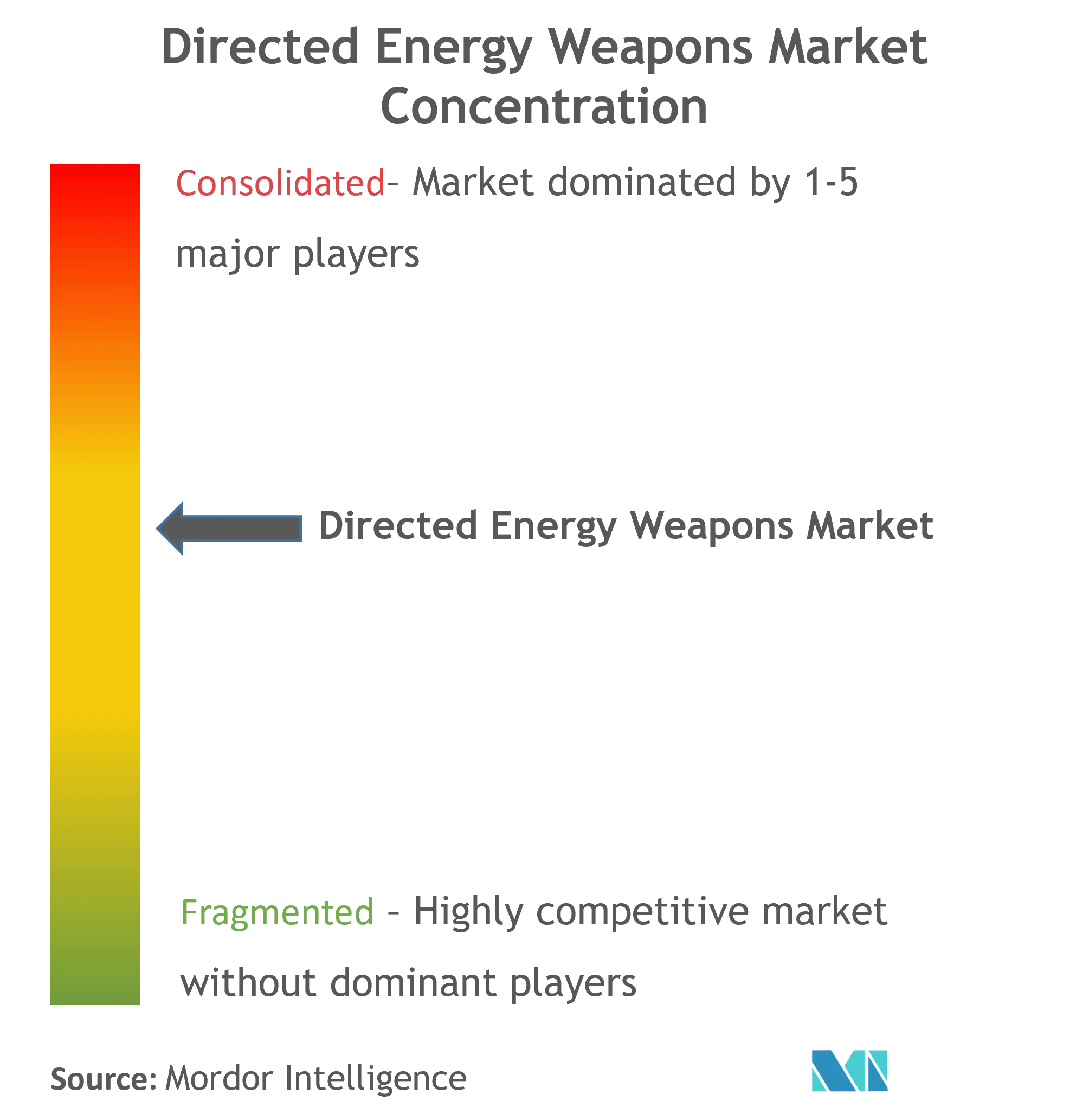
Directed Energy Weapons Market News
May 2024: The US Army Space and Missile Defense Command awarded BlueHalo a USD 95.4 million contract under the Laser Technology Research Development and Optimization (LARDO) program. This contract focuses on bolstering BlueHalo's directed energy solutions, specifically targeting aerial drones. BlueHalo's responsibilities encompass enhancing the design, manufacturing, and performance of these solutions and focusing on automation and ruggedization. Furthermore, the company is tasked with optimizing these systems' size, weight, and power to align with the army's specifications. This contract extension underscores the strategic goal of fine-tuning BlueHalo's directed energy capabilities for military applications.
December 2023: The Air Force and Navy chose Raytheon, a division of RTX, for the DEFEND program. Its mandate is to develop and test high-power microwave systems aimed at neutralizing electronic components through energy blasts. These systems are integral to the Directed Energy Front-Line Electromagnetic Neutralization and Defeat initiative. The project is valued at USD 31.3 million over three years and involves designing, building, and testing prototypes. The project is underway in Tucson, Arizona, with the delivery of prototypes slated for fiscal years 2024 and 2026.
Directed Energy Weapons Market Report - Table of Contents
1. INTRODUCTION
- 1.1 Study Assumptions
- 1.2 Scope of the Study
2. RESEARCH METHODOLOGY
3. EXECUTIVE SUMMARY
4. MARKET DYNAMICS
- 4.1 Market Overview
- 4.2 Market Drivers
- 4.3 Market Restraints
-
4.4 Porter's Five Forces Analysis
- 4.4.1 Bargaining Power of Suppliers
- 4.4.2 Bargaining Power of Buyers/Consumers
- 4.4.3 Threat of New Entrants
- 4.4.4 Threat of Substitute Products
- 4.4.5 Intensity of Competitive Rivalry
5. MARKET SEGMENTATION
-
5.1 Type
- 5.1.1 Laser
- 5.1.2 Microwave
- 5.1.3 Other Types
-
5.2 Platform
- 5.2.1 Land
- 5.2.2 Air
- 5.2.3 Sea
-
5.3 Geography
- 5.3.1 North America
- 5.3.2 Europe
- 5.3.3 Asia-Pacific
- 5.3.4 Rest of the World
6. COMPETITIVE LANDSCAPE
- 6.1 Vendor Market Share
-
6.2 Company Profiles
- 6.2.1 Lockheed Martin Corporation
- 6.2.2 The Boeing Company
- 6.2.3 Rafael Advanced Defense Systems Ltd
- 6.2.4 Rheinmetall AG
- 6.2.5 MBDA
- 6.2.6 RTX Corporation
- 6.2.7 BAE Systems plc
- 6.2.8 Northrop Grumman Corporation
- 6.2.9 Honeywell International Inc.
- 6.2.10 Elbit Systems Ltd.
- 6.2.11 L3Harris Technologies Inc.
- 6.2.12 QinetiQ Group
- *List Not Exhaustive
7. MARKET OPPORTUNITIES AND FUTURE TRENDS
** Subject To AvailablityDirected Energy Weapons Industry Segmentation
Directed energy weapons (DEWs) utilize highly focused energy beams of laser and microwaves to counter missiles, glide vehicles, naval vessels, aircraft, UAVs, etc.
The directed energy weapons market is segmented by type, platform, and geography. By type, the market is segmented into the laser, microwave, and other types. The other types sub-segment include electromagnetic weapons and sonic weapons. By platform, it is segmented into land, sea, and air. The report also covers the market sizes and forecasts in major countries across different regions. For each segment, the market size is provided in terms of value (USD).
| Type | Laser |
| Microwave | |
| Other Types | |
| Platform | Land |
| Air | |
| Sea | |
| Geography | North America |
| Europe | |
| Asia-Pacific | |
| Rest of the World |
Directed Energy Weapons Market Research FAQs
How big is the Directed Energy Weapons Market?
The Directed Energy Weapons Market size is expected to reach USD 7.14 billion in 2024 and grow at a CAGR of 17.32% to reach USD 15.86 billion by 2029.
What is the current Directed Energy Weapons Market size?
In 2024, the Directed Energy Weapons Market size is expected to reach USD 7.14 billion.
Who are the key players in Directed Energy Weapons Market?
Lockheed Martin Corporation, The Boeing Company, Rheinmetall AG, RTX Corporation and BAE Systems plc are the major companies operating in the Directed Energy Weapons Market.
Which is the fastest growing region in Directed Energy Weapons Market?
North America is estimated to grow at the highest CAGR over the forecast period (2024-2029).
Which region has the biggest share in Directed Energy Weapons Market?
In 2024, the North America accounts for the largest market share in Directed Energy Weapons Market.
What years does this Directed Energy Weapons Market cover, and what was the market size in 2023?
In 2023, the Directed Energy Weapons Market size was estimated at USD 5.90 billion. The report covers the Directed Energy Weapons Market historical market size for years: 2019, 2020, 2021, 2022 and 2023. The report also forecasts the Directed Energy Weapons Market size for years: 2024, 2025, 2026, 2027, 2028 and 2029.
Directed Energy Weapons Industry Report
Statistics for the 2024 Directed Energy Weapons market share, size and revenue growth rate, created by Mordor Intelligence™ Industry Reports. Directed Energy Weapons analysis includes a market forecast outlook to 2029 and historical overview. Get a sample of this industry analysis as a free report PDF download.



